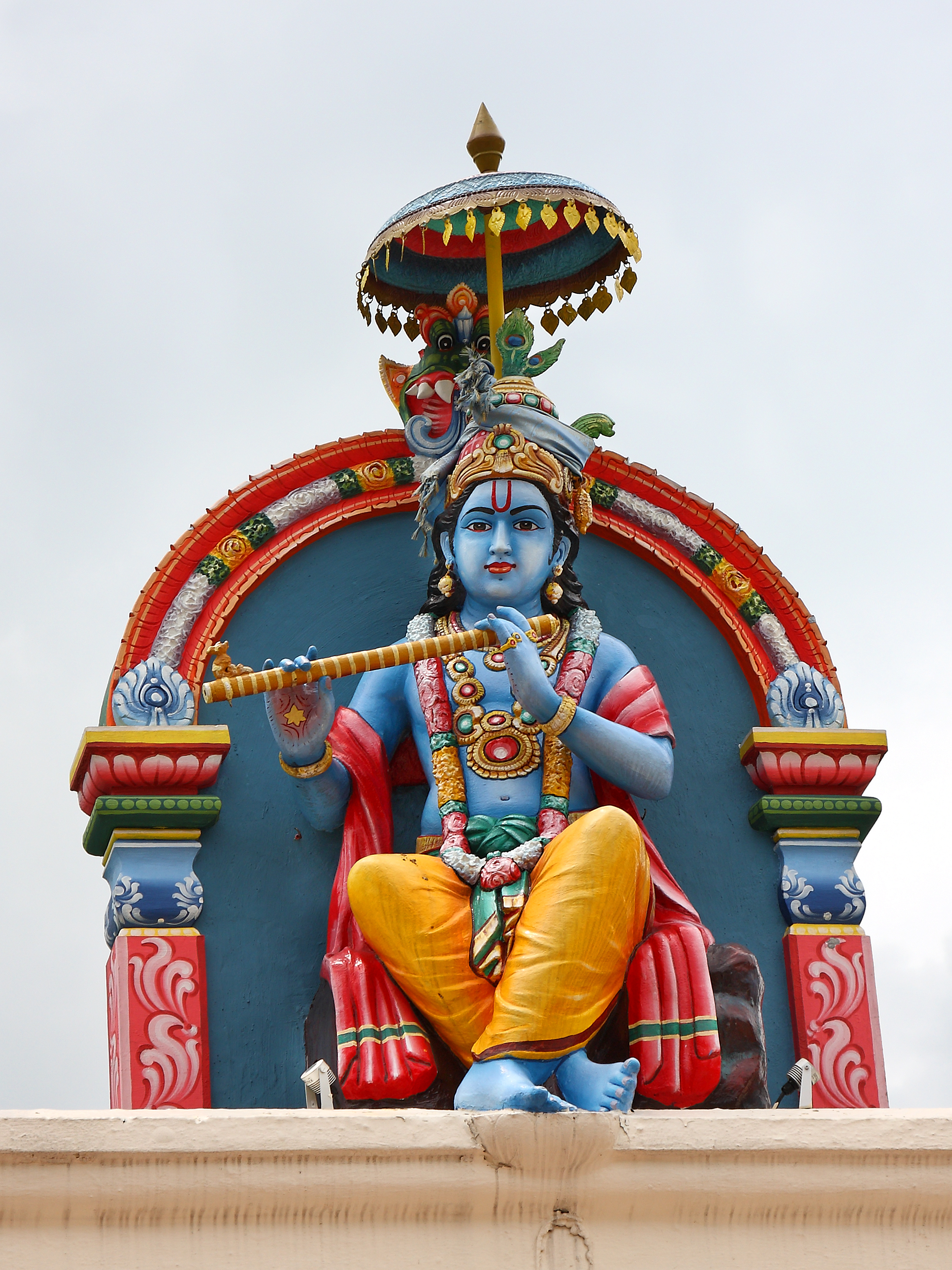
“In the previous post on yoga, we explored studies that showed a couple of important facts:
· Consistent practice of yoga is correlated with a diminishment of Christian belief.
· Practitioners typically begin yoga for physical reasons but stick with it for spiritual reasons.
We concluded with a basic definition of yoga: yoga is both a comprehensive system of human culture–physical, moral, and psychological–and it acts as a doorway on to the gently sloping paths that gradually lead up to yoga proper, that is, the spirituality of yoga rooted in hinduism.
In this post we will take a look at the hindu foundations of yoga in light of the gods found therein. St. John tells us that we should not believe every spirit, but test them to see if they are from God (cf 1 John 4:1). It’s going to be an enlightening experience, so set your intention and come join us as we explore yoga from a Catholic perspective.
++++++++++++
Part II – The gods of yoga
I’m not much of an exercise person. The practice of pumping iron or toning my body with a machine has never excited me: it seemed meaningless at best and slightly narcissistic at worst. This is one of the reasons why yoga appealed to me. It seemed to be exercise with a real meaning. What I didn’t expect was what that meaning actually is.
The word “yoga” comes from the Sanskrit yuj, which indicates “to yoke together,” “union,” “to join, to bind.”[1] Someone who practices yoga as a way of life is called a yogin or a yogi. Because yoga indicates binding, we must ask: what does yoga bind us to?
My jaw almost hit the floor when I found the answer.
To learn about yoga, at first I avoided classes and went to a local bookstore. I wasn’t ready to squeeze into yoga pants. The first paperback I purchased, chosen almost at random, was full of helpful photos of postures along with explanations and commentary. It explained what yoga “yokes” or “binds” us to: Hindu divinity or divinities. “Awaken the goddess within,” it suggested. Frightening for me as a Christian and as a male. It also invited me to consider ganesh, the “loveable” elephant-headed god, along with his friends who populate India’s pantheon. That sounds pagan, I thought. So I set the book aside and looked elsewhere. To my dismay, I discovered in a local Yoga studio something that confirmed the book’s approach: a little bronze statue of a Hindu god, presiding over the people within. It was too much even for this California boy.
Was my experience typical?
Clearly not every book on yoga promotes hindu gods, and not every yoga class has pagan statuary. But many do. The classical yoga tradition argues that all Yoga should associate with the gods of India. In order to understand why this is the case, we must uncover the hindu roots of yoga.
For Westerners who like everything, including religion, neat and tidy, boxed up and labeled, sitting on a shelf ready for inspection from a discerning customer, hinduism poses difficulties. “What we think of as one religion,” one writer notes, “is a multifarious collection of sects, traditions, beliefs, and practices that evolved from the Vedas, the world’s oldest sacred texts, and took shape across the vast Indian subcontinent over the course of many centuries.”[2] There is real difficulty in pinning down a precise doctrine of universal hindu belief because “hinduism has no central authority, no founding figure, no historical starting point, no single creed or canonical doctrine, and many holy books rather than one.” Because of this, hinduism has been called “the world’s largest disorganized religion.”[3] Nevertheless, hindus have generally recognized six principle schools that represent authentic developments of the Vedic scriptures. yoga is one of them.[4]
yoga, along with the religious beliefs and practices sheltered under the large umbrella called “hindu,” honors many gods. “hinduism is a perfect polytheism,” says a highly-respected scholar. In a real sense, this can also apply to yoga.[5] The gods are the ultimate gurus of yoga.
shiva has prominence among the gods of yoga. He is the “patron” of all yoga practitioners: “He is the deity of yogins par excellence and is often depicted as a yogin.”[6] Around his neck is a serpent, symbolizing his power over death; on his forehead is a third eye, through which he gains mystical vision and knowledge. His drumbeat is said to create the OM which reverberates in the heart and throughout the universe. In some depictions shiva assumes the lotus posture in deep meditation. In other cases shiva juggles fire while he dances with one foot in the air, indicating release from “earthly bondage.”
Some traditions include shiva in a hindu triad or trinity of gods, with brahman as the “creator”, vishnu as the “sustainer” or “preserver.” shiva is said to be “the destroyer,” the one who annihilates the illusions of the ego and therefore gains liberation into ultimate reality:
While of course many hindu deities are associated with different paths of yoga and meditation, in shiva the art of meditation takes its most absolute form. In meditation, not only mind is stopped, everything is dropped.[7]
vishnu is another important god for yoga; he is said to preserve and maintain the cosmic order dharma. Like shiva, he is depicted with blue skin and four arms and is accompanied by serpents. It is said that vishnu was incarnate nine times, the last two being the most significant: as krishna and buddha. Here I will focus on krishna.
The bhagavad-gita, part of an ancient hindu religious epic, portrays krishna as the perfect yoga guru to his disciple, the human hero arjuna. Chapter 6 of the gita contains material that would be familiar to many modern yoga practitioners. krishna defines yoga negatively as “renunciation” of illusion and positively as “yoking oneself to the supreme consciousness” (6:2). For him, a yogin is one “established in self-realization” (6:8). Through elevating himself through his own mind (6:5), a yoga practitioner attains the abode of krishna, perfect happiness, “by cessation of material existence” (6:15). The means to acquire this is by practicing control of the body, mind, and activity with specific postures and meditation techniques (6:11-18).
The yoga goddesses should not be neglected in our account. Here we can turn to the chief goddess, shakti or durga, known under different aspects. shakti is seen as the divine force that destroys evil and restores balance: she “represents the cosmic energy of destruction of the ego, which stands in the way of spiritual growth and ultimate liberation.”[8] In some instances, shakti assumes the role of parvati, the energy and consort of shiva; in other instances, the role of lakshmi, the energy and consort of vishnu. The most fearsome role shakti plays is as kali, the “dark mother” goddess, who, standing naked, wears a garland of skulls around her neck and a belt of heads around her waist, wielding a bloody sword and clutching a severed head. It is not uncommon for yoga teachers to recommend tapping into this feminine-divine source of empowerment. Here is one account:
“Ellen is a medical student, and thinks of herself as a rational person who doesn’t go in for mystical experiences. But one day as she closed her eyes and relaxed in savasana, Ellen felt a powerful maternal energy around her and “saw” the hindu goddess durga, whose picture graced the yoga studio’s back wall. For a moment, the many-armed goddess’s face lingered in front of her, looking alive and full of compassionate love. Then the image disappeared–though the sweet, strong energy stayed with Ellen for hours.[9]
Later Ellen asked Sally what the experience might mean. Sally replied: “Just sit in meditation and ask the durga energy to be with you. Then notice how you feel.” This is what Sally calls “deity yoga,” which she claims “isn’t specific to the Hindu tradition.” She says it could be practiced by anyone interested in yoga, even Christians.”
Is Sally right?
What are we to make of the pantheon of yoga gods?
It seems to me that there are four basic positions:
1. The gods and goddesses do not actually exist. They are only metaphors, imaginative fables meant to inspire the yoga practitioner. Some people may believe this, but I think it is insufficient and reductive; it does not adequately explain the cultural and experiential data available.
2. They do exist and are benevolent: they may be invoked in order to obtain energy, power, good fortune, etc. This is the position of a number of simple hindu believers.
3. They do exist but are evil, and should not be invoked. This is the position of traditional Christianity (and perhaps Islam and Judaism). “I am the Lord your God, you shall have no other gods before Me. You shall not make for yourself a graven image; you shall not bow down to them or serve them” (Exodus 20:2-5).
4. They do exist, but not in the way one might imagine. They are all manifestations of the one supreme being, the all-encompassing reality, which one could call “God.” This is the position of the more developed understanding of hinduism, an understanding that has been adopted by yoga.
In our next post we will explore the last position: that the gods exist, not in themselves, but as manifestations, personifications, or realizations of the divinity.”
Love,
Matthew
++++++++++++
[1] Mircea Eliade, Yoga: Immortality and Freedom, trans. Willard R. Trask (Princeton, NJ: Princeton University Press, 1969), 4.
[2] Philip Goldberg, American Veda (New York: Three Rivers Press, 2010), 3.
[3] Ibid.
[4] See Georg Feuerstein, The Yoga Tradition: Its History, Literature, Philosophy and Practice, 3rd Ed. (Chino Valley, AZ: Hohm Press, 2008), 72-78.
[5] Jean Varenne, Yoga and the Hindu Tradition, trans. Derek Coltman (Chicago: University of Chicago Press, 1976), 26.
[6] Feuerstein, The Yoga Tradition, 84.
[7] http://www.sanatansociety.org/hindu_gods_and_goddesses/shiva.htm#.UvpGMLQkgf8 For a retelling of the Shiva legend, see Sadhguru, “Yoga Originated from Shiva,” The Times of India 19 March, 2009. http://articles.timesofindia.indiatimes.com/2009-03-19/vintage-wisdom/28031005_1_shiva-yoga-intimacy
[8] Feuerstein, The Yoga Tradition, 87.
[9] Sally Kempton, “Oh My Goddess,” Yoga Journal Online. http://www.yogajournal.com/wisdom/1980 See also “Goddess, Where Art Thou?” http://www.yogajournal.com/wisdom/2617












